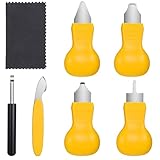Watch Worth & Value Calculator
How much is your watch worth? Use our “Watch Worth & Value Calculator” below. It’s also available for download as an app: Download iOS App / Download Android App
What this does: Estimates a wristwatch’s market value using MSRP, Brand Heat, age, condition, box/papers, material, and complications. It shows a Low / Expected / High range and a transparent factor breakdown.
Important: This is a rough market estimate, not a formal appraisal. Always confirm with recent comparable sales and/or a professional.
Quick Start
- Brand — start typing and pick from the list; a suggested Brand Heat multiplier appears (you can fine-tune it).
- Model / Reference (optional) — for your notes only.
- MSRP — enter the original retail price in your currency (symbol only; no FX conversion).
- Currency — $, €, or £ (display only).
- Production/Purchase Year — sets the age curve (includes a modest vintage bump after ~30 years).
- Condition — pick the closest description (Mint → Poor).
- Box & Papers / Material / Complications — select what applies. The estimate and breakdown update instantly.
Use Reset anytime to clear inputs and start fresh.
What Each Field Means (and typical multipliers)
MSRP
The base price the entire calculation builds from. If you don’t know the exact MSRP, use the best documented figure for your specific reference/version.
Brand Heat (Market Retention)
A slider (≈ 0.50×–1.20×) reflecting how strongly a brand tends to hold value on the secondary market. Example starting points (adjust to current comps): Rolex ≈ 1.05×, Patek Philippe ≈ 1.08×, Omega ≈ 0.88×, Seiko ≈ 0.80×, Timex ≈ 0.74×.
Condition
| Condition | Multiplier |
|---|---|
| New / Unworn | 1.00× |
| Like New (Mint) | 0.93× |
| Very Good | 0.85× |
| Good (light wear) | 0.75× |
| Fair | 0.62× |
| Poor / Needs Service | 0.45× |
Box & Papers
| Set | Multiplier |
|---|---|
| Full set | 1.00× |
| Box only | 0.95× |
| Papers only | 0.92× |
| No box / papers | 0.88× |
Case Material
| Material | Multiplier |
|---|---|
| Stainless steel | 1.00× |
| Titanium | 0.95× |
| Two-tone | 0.92× |
| Gold | 0.85× |
| Platinum | 0.88× |
| Ceramic/Carbon | 0.90× |
Complications
| Complication set | Multiplier |
|---|---|
| Time/Date | 1.00× |
| GMT / Dual-time | 1.05× |
| Chronograph | 1.08× |
| Annual/Perpetual Calendar | 1.12× |
| Tourbillon / Minute Repeater | 1.18× |
How the Estimate Is Calculated (exact formula)
Estimate = MSRP × Heat × Age × Condition × Box/Papers × Material × Complications
The output displays Low (−10%), Expected (mid), and High (+10%) bands, plus a factor-by-factor table so you can see why the number lands where it does.
Understanding the Age Curve (why older isn’t always cheaper)
- Starts from MSRP and applies a gentle exponential decay with time.
- After ~30 years, many pieces become “vintage collectible,” so the curve includes a modest vintage bump.
- The age factor is clamped within a reasonable floor/ceiling to avoid unrealistic extremes.
Practical Tips to Get a Smarter Number
For Sellers
- Use real MSRP for your exact reference/spec.
- Be honest on condition (service needs, polishing, crystal, bracelet stretch).
- Document your set (full set helps; service receipts/timegrapher reports support the upper band).
- Check “Heat” vs. live comps and nudge the slider as needed.
For Buyers
- Compare the bands: Above “High” — what’s special? Below “Low” — verify authenticity/condition.
- Read the fine print: Full set should include the correct box, stamped papers, hangtags, links, manuals.
- Metal ≠ guaranteed premium: Two-tone and some precious metals can be less liquid than steel.
- Complications add cost/maintenance; multipliers reflect demand without assuming hype.
For Vintage & Indie
- Rarity and provenance can dwarf generic multipliers.
- Independent brands vary widely; start with suggested Heat, then adjust to recent sales/auctions.
FAQs
Does the calculator convert currencies?
No — the currency toggle is cosmetic (symbol only). If you want a USD estimate from a € MSRP, convert first, then enter that number.
Is this a professional appraisal?
No. It’s a market-style estimate using transparent multipliers. Get a professional appraisal for insurance, estate, or legal needs.
What if my watch had a price increase after launch?
Use the original MSRP that best matches your watch’s production period and spec.
How accurate is it?
Accuracy depends on input quality and how closely Brand Heat matches current demand. Always verify against recent comps.
Why do older watches sometimes value higher?
Desirability, scarcity, and collector interest — hence the vintage bump after ~30 years.
Example Workflow (sanity-check)
- Enter MSRP and brand → review the suggested Heat.
- Add the year, choose condition, set box/papers.
- Choose material and complications.
- Check the Expected price and compare to recent sales.
- Adjust Heat a few points if comps are consistently higher/lower.
Disclaimer: This calculator provides indicative pricing guidance. Realized values vary with market cycles, regional demand, rarity, dial/text variance, provenance, originality (hands/dial/bezel/bracelet), service history, and completeness. Always verify with multiple sources.








